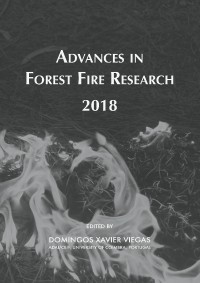Please use this identifier to cite or link to this item:
https://hdl.handle.net/10316.2/44588| DC Field | Value | Language |
|---|---|---|
| dc.contributor.author | Sullivan, A. L. | |
| dc.contributor.author | Cruz, M. G. | |
| dc.contributor.author | Hilton, J. E. | |
| dc.contributor.author | Plucinski, M. P. | |
| dc.contributor.author | Hurley, R. | |
| dc.date.accessioned | 2018-11-09T14:23:29Z | |
| dc.date.accessioned | 2020-09-06T17:31:35Z | - |
| dc.date.available | 2018-11-09T14:23:29Z | |
| dc.date.available | 2020-09-06T17:31:35Z | - |
| dc.date.issued | 2018 | - |
| dc.identifier.isbn | 978-989-26-16-506 (PDF) | |
| dc.identifier.uri | https://hdl.handle.net/10316.2/44588 | - |
| dc.description.abstract | Understanding wildland fire behaviour between ignition and attainment of the ‘steady state’ rate of spread is important for determining the speed of development of the fire and the accurate identification of the window of maximum effective first attack. As part of a larger experiment studying the behaviour of free-burning experimental grassland fires conducted in the open, the opportunity was taken to gather data on the development, behaviour and spread of fires ignited at a point, as would generally occur in a wildfire. These experimental fires, carried out in fully cured open improved pasture approximately 10 km NW of Braidwood, NSW, Australia, were conducted on 0.1—0.2 hectare plots and provided the most detailed insights into the behaviour of nascent fires burning in the open conducted in Australia since the work of McArthur (1966) and Cheney et al (1993). This talk provides a general overview of this subset of experiments and the methods used to collect high spatial resolution data about the growth and development of free-burning point ignition fires in the open. As most fires in this series were very short-lived and were open to the vagaries of the prevailing wind field, traditional methods of measuring and documenting fire behaviour and spread were not practical—fires generally lasted less than two minutes. As a result, video footage taken from a quad-copter unmanned aerial vehicle (or remotely piloted aircraft or drone) hovering above the fire was used to map the progression of each fire. Details of the method by which footage is rectified and corrected, scaled and digitized will be provided as will a summary of the results obtained thus far. | eng |
| dc.language.iso | eng | - |
| dc.publisher | Imprensa da Universidade de Coimbra | por |
| dc.relation.ispartof | http://hdl.handle.net/10316.2/44517 | por |
| dc.rights | open access | - |
| dc.subject | Fire behaviour | eng |
| dc.subject | fire growth | eng |
| dc.subject | acceleration | eng |
| dc.subject | field experiments | eng |
| dc.subject | wildfire | eng |
| dc.subject | analysis | eng |
| dc.subject | drone | eng |
| dc.subject | remotely piloted aircraft | eng |
| dc.title | Study of growth of free-burning grass fires from point ignition | por |
| dc.type | bookPart | por |
| uc.publication.firstPage | 643 | - |
| uc.publication.lastPage | 649 | - |
| uc.publication.location | Coimbra | por |
| dc.identifier.doi | 10.14195/978-989-26-16-506_71 | - |
| uc.publication.section | Chapter 3 - Fire Management | por |
| uc.publication.digCollection | PB | por |
| uc.publication.orderno | 71 | - |
| uc.publication.area | Ciências da Engenharia e Tecnologias | por |
| uc.publication.bookTitle | Advances in forest fire research 2018 | - |
| uc.publication.manifest | https://dl.uc.pt/json/iiif/10316.2/44588/204239/manifest?manifest=/json/iiif/10316.2/44588/204239/manifest | - |
| uc.publication.thumbnail | https://dl.uc.pt/retrieve/11059087 | - |
| uc.publication.parentItemId | 55072 | - |
| uc.itemId | 68854 | - |
| item.grantfulltext | open | - |
| item.fulltext | With Fulltext | - |
| Appears in Collections: | Advances in forest fire research 2018 | |
Files in This Item:
| File | Description | Size | Format | |
|---|---|---|---|---|
| study_of_growth_fo_free-burning_grass.pdf | 1.15 MB | Adobe PDF |  |
Items in DSpace are protected by copyright, with all rights reserved, unless otherwise indicated.
